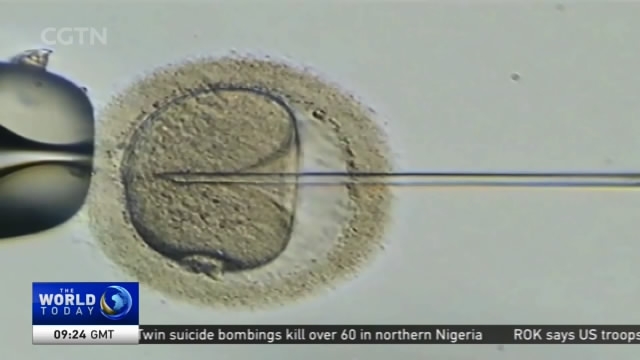
18:31, 02-May-2018
Fertility Service: China and US cooperate on assisted reproductive medicine
03:24

The US and China are undertaking an ambitious collaboration in assisted reproductive medicine -- possibly tranforming the 24-billion-dollar industry. The move under Beijing's 'One Belt, One Road' initiative would grow China's medical tourism sector and meet the country's growing demand for ferility services. Our correspondent Liling Tan reports from New York.
This tiny container is taking in-vitro fertilization — or IVF — into the 21st century, by disrupting a decades-long industry.
KATIE KARLOFF CEO, INVO BIOSCIENCE "It actually is the first new method of doing IVF since the beginning or IVF."
The device, called INVOcell, enables fertilization and early embryo development to take place inside a woman's body, instead of in a lab.
KATIE KARLOFF CEO, INVO BIOSCIENCE "This little device here, the INVOcell, is allowing patients to get treated at a less expensive cost because it does not require an IVF laboratory to do the job."
It nearly halves the cost of traditional IVF methods, says Katie Karloff, who wants to bring it to China to meet growing demand for reproductive services.
LILING TAN NEW YORK "The industry estimates that the infertile population of China is roughly around 40 million people, and that creates a huge opportunity for a multibillion dollar industry, that can be served by innovation, state-of-the-art technology, and best practices from both the demand side in China, and the supply side here in the US."
The collaboration, announced on May 1st, brought Chinese and American experts to Global Fertility and Genetics in Manhattan.
DR. HU BO CHAIRMAN, HMO, CHINESE MEDICAL DOCTOR ASSOC. CHAIRMAN, CIMING BOAO INTERNATIONAL HOSPITAL "In recent years, the total number of cases in China has surpassed that of the United States, and China has improved a lot in terms of experience. However, in terms of technology, China still needs further cooperation and exchange, in academic and technical areas as well as talent training."
DR. KEVIN DOODY, BOARD DIRECTOR AMERICAN SOCIETY FOR REPRODUCTIVE MEDICINE "I think we're at the beginning of a systematic collaboration between China and the US. This is an emerging time for China with the growing need for assisted reproductive technology services. Unfortunately, the supply is not there, the ability to meet that demand, the infrastructure etc needs to be built out, and that will take some time to do that. In the meanwhile, many Chinese citizens are going elsewhere to the US or other places to get their needs met."
The plan is to bring US expertise to China, enable patients with special medical needs to go to the US for treatment, and establish international standards of quality assurance.
The collaboration has its eye on the Hainan Boao Lecheng International Medical Tourism Pilot Zone, a medical hub approved by the State Council, where preferential policies include fast-track approval for pre-approved drugs, technology and medical devices.
And it's where the INVOcell may have a shot as soon as early June, Liling Tan, CGTN, New York.

SITEMAP
Copyright © 2018 CGTN. Beijing ICP prepared NO.16065310-3
Copyright © 2018 CGTN. Beijing ICP prepared NO.16065310-3